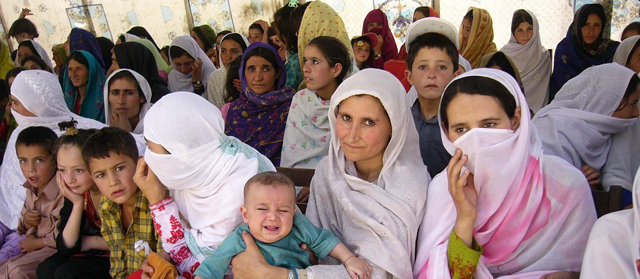-
UNFPA State of World Population 2010
›Today marks the release of the United Nations Population Fund (UNFPA) annual State of the World Population Report. But the 2010 edition, “From Conflict and Crisis to Renewal: Generations of Change,” is unlike those that have come before. In lieu of the traditional statistic-driven report, this year’s edition has enlisted another tool to document living conditions across the world — storytelling. In addition to demographers, the UNFPA looked to journalists to fan out across the world to gather stories on the ground and paint a portrait of the challenges and opportunities facing today’s global population that goes beyond the numbers, with particular focus on gender issues and human insecurity.
For more on the UNFPA report, be sure to listen to The New Security Beat’s interview with one of its authors, Barbara Crossette, who talks about her experiences dealing with family planning around the world, as part of our ongoing Pop Audio series.
Video Credit: UNFPA. -
Laurie Mazur at SEJ 2010 on ‘A Pivotal Moment: Population, Justice, and the Environmental Challenge’
› “Right now, half the world’s population – some 3 billion people – are under the age of 25,” began Laurie Mazur on the “Population, Climate, and Consumption” panel at the Society for Environmental Journalists 20th Annual Conference. “It’s the largest generation ever that’s coming of age, and the choices that those young men and women make about childbearing will determine whether world population…grows to anywhere between 8 and 11 billion by the middle of this century.”
“Right now, half the world’s population – some 3 billion people – are under the age of 25,” began Laurie Mazur on the “Population, Climate, and Consumption” panel at the Society for Environmental Journalists 20th Annual Conference. “It’s the largest generation ever that’s coming of age, and the choices that those young men and women make about childbearing will determine whether world population…grows to anywhere between 8 and 11 billion by the middle of this century.”
“The good news is that everything we need to do to slow population growth is something we should be doing anyway,” she continued. Mazur is the author of A Pivotal Moment: Population, Justice, and the Environmental Challenge and director of the Population Justice Project.
She was joined on the panel by Brian O’Neill, who spoke about a new study examining the impact of demographics on carbon emissions, and Jack Liu, who spoke about the impact of household size on emissions in China.
The “Pop Audio” series offers brief clips from ECSP’s conversations with experts around the world, sharing analysis and promoting dialogue on population-related issues. Also available on iTunes. -
The “Condom King” speaks at TEDxChange on Poverty Reduction and a “9th MDG”
›“We have now found the weapon of mass protection,” said Mechai Viravaidya (a.k.a. the “Condom King”) at the recent TEDxChange event in New York. Viravaidya is the founder and chairman of the Population and Community Development Association and a former senator of Thailand. He spoke about his innovative approaches to addressing Thailand’s once high rates of poverty, child mortality, and HIV through the promotion of family planning and condom use.
-
Youth Delegation Makes a Splash at UNFCCC
›October 11, 2010 // By Wilson Center Staff This weekend wrapped up an intercessional meeting of the UN Framework Convention on Climate Change (UNFCCC) in Tianjin, China – one of the last before this December’s big follow-up to Copenhagen in Cancun (COP-16).
This weekend wrapped up an intercessional meeting of the UN Framework Convention on Climate Change (UNFCCC) in Tianjin, China – one of the last before this December’s big follow-up to Copenhagen in Cancun (COP-16).
Alex Starks, formerly of CNAS’s Natural Security and now shadowing the U.S. climate delegation with the Adopt a Negotiator Project, got a chance to make a brief speech on behalf of a coalition of youth-orientated NGOs, and according to onlookers the speech made quite a stir amongst the assembly. Karl Burkart of tcktcktck.org wrote:Normally these 2 minute NGO speeches are politely tolerated by UN negotiators waiting to get on with the day’s business, but in this case Alex’s talk had ripple effects. The LCA (Long-term Cooperative Agreement) chair took the time to formally comment on her remarks, and later in the day the chief EU negotiator said, “If you need a reminder about what we’re up against, listen to the youth delegate’s statement.”
The full text of Alex’s speech is worth a read. Stay tuned for more on the UNFCCC and the lead-up to Cancun, as Alex has promised a guest contribution to The New Security Beat in the coming days!
Photo Credit: Adapted from “IMG_2474,” courtesy of flickr user benkamorvan. -
Wilson Center Scholar Huma Yusuf on Pakistan’s Population Policy: Will it Work?
›October 8, 2010 // By Wilson Center StaffExcerpt from op-ed by Huma Yusuf in Dawn:
The best news Pakistanis have received in the past week comes in the form of the National Population Policy 2010. The policy recognises that demographics are the key to promoting economic development and security in Pakistan. It also prioritises family planning — particularly in an effort to promote birth spacing — as the best strategy for achieving ambitious population targets (2.1 births per woman in 2025).
In many ways, the story of Pakistan is one of a failure of family planning. Although the Family Planning Association of Pakistan was set up as early as 1952, we have seen a five-fold increase in our population between 1951 and 2009, from 34 million to 171 million.
The urgent need for revamped family planning service delivery cannot be understated. Although 96 per cent of married Pakistani women are aware of at least one modern contraceptive method, only 22 per cent are currently using modern contraceptives, while another eight per cent use less effective traditional methods. One quarter of married women want to wait before having another child, or do not want more children, but are not using contraception. And 24 per cent of married women admit that their last child was mistimed or unwanted.
Many Pakistanis bemoan the prevalence of abortion here (a 2004 Population Council study estimates that there are 890,000 abortions annually), but this too should be understood as a shortcoming of our government’s family planning service delivery. According to the 2006-07 Pakistan Demographic Health Survey, 65 per cent of women who had an abortion were over the age of 30, while 80 per cent had more than three children. In this context, the population policy’s emphasis on family planning is a welcome paradigm shift.
Continue reading on Dawn.
Photo Credit: Adapted from “chitral photos,” courtesy of flickr user groundreporter. -
Tackling Youth Unemployment, Instability in Kenya
›Today, Kenya’s youth unemployment rate stands at 65 percent, among the highest in the world. Three in five unemployed Kenyans are 15 – 35 years old. The situation is exacerbated by a shrinking economy, political instability, and pervasive income inequality.
Significantly, youth are engaged in the informal sector, which is largely unregulated and subjects workers to low earnings and long hours, without any formal contract. Suffering under a slow-growing economy, youth, whether well educated or uneducated, have increasingly turned to crime and violence, serving as watu wa mkono (handymen) to the ruling elite and intimidating and harassing their political opponents.Violence during Kenya’s disputed 2007 elections left approximately 1,133 people dead and 650,000 displaced from their land. Many of these atrocities were committed by youth, for sums as low as $6. With the 2012 elections fast approaching, Kenya risks renewed violence if its daunting youth unemployment rate is not properly addressed.
Against this backdrop, the Kenyan government has established the Youth Enterprise Development Fund (YEDF) and Kazi kwa Vijana (KKV), which means “jobs for youth,” to boost employment and entrepreneurship among people 18 to 35 years old.
Through YEDF, groups of up to 12 people can submit a business plan and apply for funding, as well as other services such as training, mentorship, and market access. The fund also connects youth with local and international job markets. KKV facilitates access to temporary, labor-intensive jobs for generally low wages, and also offers some business training.
Given the high poverty levels among youth in Kenya, temporary jobs can help young people learn the marketable skills they need to find decent work. But it’s not a long-term solution, as these low-paying jobs can also trap people in poverty, making crime and violence seem like the only viable exit.
Kenya would do well to learn from other countries’ efforts, where similar programs have long existed. For example, Italy’s Imprenditorialita Giovanile, or “Young Entrepreneurs’ Company,” and the UK’s Prince Trust exist solely to support young people’s start-up businesses.
Like Kenya’s efforts, these two programs provide training and mentoring to young people. However, they also have autonomy from their respective governments, which gives them freedom to operate without political interference and burdensome bureaucracy. Services are delivered by highly competent, successful entrepreneurs, who inspire youth to become entrepreneurs, not as an alternative to joblessness, but as a genuine career path with financial reward and work satisfaction. Through these programs, youth have managed to start and sustain viable businesses, and attain financial independence and stability.
Compared to these cases, Kenya’s KKV and YEDF fall short. Their activities overlap, and their objectives are too broad, which makes them unachievable within a reasonable timeframe.
They are also constrained by heavy government control. The prime minister’s office oversees KKV, while the Ministry of Sports and Youth Affairs manages YEDF. As a consequence, the programs are burdened by politics rather than buoyed with professionalism.
The tendency to treat youth as a homogenous group could isolate some young people who cannot fulfill YEDF’s requirements, such as a business development plan, a registered group, or an existing bank account. The rules should be more flexible and needs-based in order to benefit some of the needy and illiterate youth who require more rigorous training and support to succeed.
Finally, the programs’ near-sighted focus on temporary employment is but a bandage; Kenya needs long-term strategies to enable youth to access more rewarding and productive work.
Fundamentally, the problem requires properly planned, well-structured, and broad-based programs, and so far the government seems to be tinkering at the superficial level without a long-term, comprehensive plan. Accelerating economic growth is central to creating employment opportunities for youth, as well as providing market-driven education, training, and life skills.
In order to make a smooth transition to adulthood, young people require decent work and the ability to actively contribute to economic and political development and stability. Short of this, youth will remain at the margin of the economy, to serve as the violent watu wa mkono in 2012 and beyond.
Margaret Wamuyu Muthee is Programs Manager for Kenya’s University of Nairobi Center for Human Rights and Peace, and is currently an Africa Program Scholar at the Woodrow Wilson Center.
Photo Credit: Adapted from “Promulgation,” courtesy of flickr user ActionPixs (Maruko). -
Water, Power, Trash, and Security: Interview with Mishkat Al Moumin, First Iraqi Minister of the Environment
›August 31, 2010 // By Schuyler NullAs the final American combat brigade pulls out of the country, the prevailing opinion in the United States about Iraq at the moment seems to be one of “bad politics are better than no politics,” and that despite continued violence (albeit significantly lessened from 2006-2007 levels), the American mission is largely finished. However, serious challenges remain, one of the most significant being the government’s continued inability to supply basic services to a growing population.
-
GMHC 2010: Empowering the Next Generation
›“We do not need new legislation… we need affordable, effective, and scalable solutions,” said Shn Gulamnabi Azad, Minister of Health, India, at the opening ceremony of the first-ever Global Maternal Health Conference in New Delhi. Co-hosted by the Maternal Health Task Force and the Public Health Institute of India, this three-day technical meeting builds upon the momentum of Women Deliver and the G8 summit by bringing together 700 researchers, program managers, advocates, media, and young people to exchange ideas, share data, develop strategies, and identify solutions for reducing maternal mortality.
In order to reduce India’s maternal mortality rates, Azad called for the repositioning of family planning programs to include maternal and child health and not limit the scope of services to population control as historically executed. Improving family planning and maternal health services must also address the reproductive health needs of adolescent girls, and India is currently developing a new ministry that will target gender inequality, poverty, early child marriages, as well as other critical health issues important to young girls such as the dissemination of sanitary napkins.
“Although the legal age of marriage is 18, there are districts in India where 35 percent of the population is married between the ages of 15-18,” said Azad. During the side event “Adolescent Girls: Change Agents for Healthy Mother and Child,” technical experts such as Anil Paranjap of the Indian Institute of Health Management presented evidence that girls who marry between 15-18 are five times more likely to die during childbirth than women in their early 20’s.
“We still have deep-rooted subordination that makes it very difficult for young women to realize their sexual and reproductive health rights,” said Sanam Anwar with the Oman Medical College. Interventions such as the UDAAN project – a private-public partnership between the Center for Development and Population Activities (CEDPA) and the Government of India – demonstrate promising solutions for empowering young people through the use of existing infrastructure. In collaboration with teachers, parents, principals, and students, this project successfully increased leadership skills and improved youth knowledge on menstruation, health, friendship, peer pressure, early marriage, and reproductive health, said Sudipta Mukhopadhyay of CEDPA.
Empowering “young people” to improve maternal health also requires that the community support committed new thinkers and future leaders. The Young Champions of Maternal Health Program is a unique and refreshing group of young professionals from 13 countries dedicated to improving maternal health, and I look forward to learning how this new energy will further the maternal health agenda.
Originally posted at Maternal Health Task Force, by Calyn Ostrowski of the Woodrow Wilson International Center for Scholars, Coordinator of the Maternal Health Dialogue Series in partnership with the Maternal Health Task Force and UNFPA.
Photo Credit: “Indian Girl” courtesy of flickr user Jarek Jarosz.
Showing posts from category youth.









